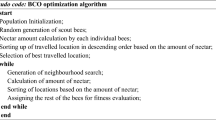Abstract
Facility layout (FL) design presents a particularly interesting area of study because of its relatively high level of attention to aesthetics and usability qualities, in addition to common engineering objectives such as cost and performance. However, this generally presents a difficult combinatorial optimization problem for engineers. Swarm intelligence, an approach to decision making that integrates collective social behavior models such as the bee algorithm (BA) and particle swarm optimization (PSO), is being increasingly used to resolve various complex optimization problems. In order to integrate BA global search ability with the local search advantages of PSO, this study proposes a new optimization hybrid swarm algorithm—the particle bee algorithm (PBA) which imitates the intelligent swarming behavior of honeybees and birds. This study also proposes a neighborhood-windows technique for improving searching efficiency as well as a self-parameter-updating technique for preventing trapping into a local optimum in high-dimensional problems. This study compares PBA performance against BA and PSO performance in practical FL problem. Results show PBA performance is comparable to those of BA and PSO and can be efficiently employed to solve practical FL problem with high dimensionality.











Similar content being viewed by others
References
Michalek JJ, Choudhary R, Papalambros PY (2002) Architectural layout design optimization. Eng Optim 34(5):461–484
Anjos MF, Vannelli A (2002) A new mathematical programming framework for facility layout design. http://www.optimization-online.org/DB_HTML/2002/03/454.html
Yeh I-C (2006) Architectural layout optimization using annealed neural network. Autom Constr 15(4):531–539
Sirinaovakul B, Thajchayapong P (1996) An analysis of computer-aided facility layout techniques. J Comput Integr Manuf 9(4):260–264
Moore JM (1976) Facilities design with graph theory and strings. Omega 4(2):193–203
Hassan MMD, Hogg GL (1991) On constructing a block layout by graph theory. J Prod Res 29(6):1263–1278
Cheng MY (1992) Automated site layout of temporary construction facilities using geographic information systems (GIS). PhD Thesis. University of Texas at Austin, Texas
Tommelein ID, Levitt RE, Confrey T (1991) SightPlan experiments: alternate strategies for site layout design. J Comput Civil Eng 5(1):42–63
Elbeitagi E, Hegazy T (2001) A hybrid AI-based system for site layout planning in construction. Comput Aided Civil Infrastructure Eng 16(2):79–93
Abdinnour-Helm S, Hadley SW (2000) Tabu search based heuristics for multi-floor facility layout. Int J Prod Res 38(2):365–383
Suresh G, Sahu S (1993) Multiobjective facility layout using simulated annealing. Int J Prod Econ 32(2):239–254
Gero JS, Kazakov V (1997) Learning and reusing information in space layout planning problems using genetic engineering. Artif Intell Eng 11(3):329–334
Li H, Love PED (2000) Genetic search for solving construction site-level unequal-area facility layout problems. Autom Constr 9(2):217–226
Osman HM, Georgy ME, Ibrahim ME (2003) A hybrid CAD-based construction site layout planning system using genetic algorithms. Autom Constr 12(6):749–764
Hegazy T, Elbeltagl E (1999) EvoSite: evolution-based model for site layout planning. J Comput Civil Eng 13(3):198–206
Elbeitagi E, Hegazy T, Hosny AH, Eldosouky A (2001) Schedule-dependent evolution of site layout planning. Constr Manag Econ 19(7):689–697
Bonabeau E, Dorigo M, Theraulaz G (1999) Swarm intelligence: from natural to artificial intelligence. Oxford University Press, New York
Dorigo M (1992) Optimization, learning and natural algorithms. PhD Thesis. Politecnico di Milano, Italy
Li XL (2003) A new intelligent optimization-artificial fish swarm algorithm. PhD Thesis. Zhejiang University of Zhejiang, China
Kennedy J, Eberhart RC (1995) Particle swarm optimization. In: Proceedings of the 1995 IEEE international conference on neural networks, vol 4, pp 1942–1948
Pham DT, Koc E, Ghanbarzadeh A, Otri S, Rahim S, Zaidi M (2006) The bees algorithm—a novel tool for complex optimization problems. In: Proceedings of the second international virtual conference on intelligent production machines and systems, pp 454–461
Yang XS (2005) Engineering optimizations via nature-inspired virtual bee algorithms. Lect Notes Comput Sci 3562:317–323
Karaboga D, Akay B (2009) A comparative study of Artificial Bee Colony algorithm. Appl Math Comput 214:108–132
Basturk B, Karaboga D (2006) An Artificial Bee Colony (ABC) algorithm for numeric function optimization. In: IEEE swarm intelligence symposium 2006, Indianapolis, IN
Ozbakir L, Baykasog A, Tapkan P (2010) Bees algorithm for generalized assignment problem. Appl Math Comput 215:3782–3795
Tsai HC (2010) Predicting strengths of concrete-type specimens using hybrid multilayer perceptions with center-unified particle swarm optimization. Expert Syst Appl 37:1104–1112
Parsopoulos KE, Vrahatis MN (2007) Parameter selection and adaptation in unified particle swarm optimization. Math Comput Model 46(1):198–213
Korenaga T, Hatanaka T, Uosaki K (2006) Improvement of particle swarm optimization for high-dimensional space. In: Proceedings of the 2006 SICE-ICASE international joint conference
Jagielski R, Gero JS (1997) A genetic programming approach to the space layout problem. In: Junge R (ed) CAAD futures. Kluwer, Dordrecht, pp 875–884
Hahn PM, Jrarup J (2001) A hospital facility layout problem finally solved. J Intell Manuf 15(5–6):487–496
Eberhart R, Shi Y, Kennedy J (2001) Swarm intelligence. Morgan Kaufmann, San Francisco
Cheng MY, Lien LC (2011) A hybrid AI approach particle bee algorithm (PBA) for complex optimization problems. Appl Math Comput (under review)
Author information
Authors and Affiliations
Corresponding author
Rights and permissions
About this article
Cite this article
Cheng, MY., Lien, LC. A hybrid AI-based particle bee algorithm for facility layout optimization. Engineering with Computers 28, 57–69 (2012). https://doi.org/10.1007/s00366-011-0216-z
Received:
Accepted:
Published:
Issue Date:
DOI: https://doi.org/10.1007/s00366-011-0216-z




